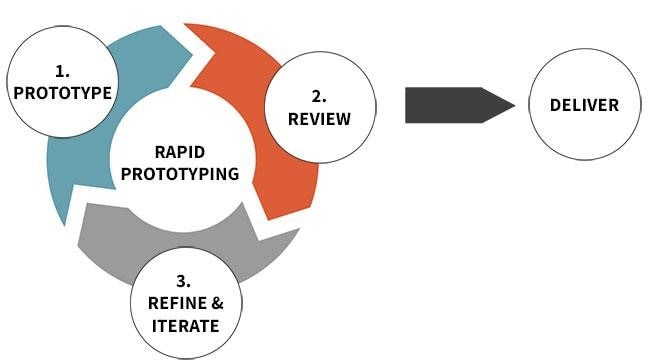3 Rapid Prototyping Exercises to Improve Your UX Skills

"A good picture is worth a thousand words", this old saying tells the core content of the user interface prototyping. The use of various visual materials to directly show the software system and interface details is far more than using a thousand words to describe something orally. Design and development specifications are clearer and more intuitive.
Rapid prototyping refers to the process by which designers do quick prototyping to simulate the future state of the website or software system. Which is convenient for more relevant personnel, such as users, investors, developers, and designers. The key to creating high-quality rapid prototypes is that designers need to start from user feedback, combined with appropriate prototyping methods, and quickly modify software prototypes, so as to propose design solutions that can better meet user needs.
Rapid prototyping can help a team of UI/UX designers to quickly test and iterate a variety of design ideas and methods. So that they can use more intuitive and visual design materials in the process of communication and discussion. Rather than just verbal descriptions. At the same time, it can ensure that everyone who participates can get a consistent understanding, reducing or even avoiding the risk of missing some important needs. Ultimately achieve the goal of completing the software design faster and faster.
What is Rapid Prototyping?
Rapid prototyping is currently on everyone's lips, with many researchers saying that technology is one of the determining megatrends of the near future. But what is actually meant by this term? Rapid Prototyping is an iterative process used to show what kind of website or application will be made; the purpose is to obtain feedback and get verification from users, shareholders, developers, and designers.
Rapid prototyping plays an essential role in making such goals feasible. It encompasses a number of different techniques and allows UX designers to use a variety of production and testing methods to refine their ideas. With the innovative rapid prototyping process, companies can produce high-precision prototypes in a short time.
If used properly, the rapid prototyping method will enhance communication between all parties and reduce the risk of constructing false requirements, thereby improving design quality.
The process of rapid prototyping

A prototype often starts with a very simple model of a key part of the product, and in each iteration, it becomes more and more complex based on more and more data collected from user feedback. The rapid prototyping method consists of a development trilogy of multiple iterations on-demand:
1. Prototype: Create a visual model of a solution or user interface.
2. Review: Share the prototype with users and make improvements according to their needs and expectations.
3. Refine: Based on feedback, identify the parts that need improvement or refinement.
With rapid prototyping, design and function can be optimized quickly and easily, which is associated with numerous advantages for companies. In addition, the rapid prototyping process also includes 3D printing. The use of rapid prototyping is associated with a whole range of advantages for companies. We present the most important of them to you in the following:
Faster production of the prototype
Using the rapid prototyping process, prototypes can be produced much faster than with conventional methods. Thanks to the fast prototyping techniques, so can be prototypes can be designed much earlier and more frequently.
Time and cost-effective
Rapid prototyping does not require any previous costly or time-consuming tool manufacture. Many different geometries can be created with one and the same rapid prototyping device. Errors and inaccuracies can be identified much better and faster which is also associated with significant time and cost savings.
New technical possibilities
Another great benefit of rapid prototyping is that it allowed for more experimental ways of manufacturing. With bioprinting 3D printers, real human tissue can be imitated, among other things. Several research projects around the world are already working on printing entire organs.
Improving the product
The second advantage is to get a three-dimensional impression of the product with the help of rapid prototyping and thus to better sound out the weak points. With the creation of each new prototype, the old weak points are eliminated until a product ready for series production is finally available. With the previous construction methods, this would only have been possible with considerable investment.
3 Rapid Prototyping Exercises to Improve your UX Skills
1. 8–6–4–2 Rapid Prototype Method.
8–6–4–2 rapid prototyping is a very efficient method to improve your UX skills. Practicing this exercise helps you incorporate feedback at all stages of a design. It's also a quick exercise to get your team involved in the early stages of a project -especially teams that are not familiar with UX processes. Some UX designers use this technique to help me work through problems quickly -it takes less than 30 minutes to go through this exercise and have work to show for it. It's also a quick technique to put into practice when working on your own projects or design challenges.
Technique: Sketch for 8 minutes, 6 minutes, 4 minutes, and 2 minutes with 2-minute feedback sessions in between. It helps to provide the person giving you feedback with a bit of context about the problem before you begin sketching.
2. A twist on the #DailyUI Challenge
The challenge of Daily UI began with a designer, Paul Flavius Nechita, who posted an interface work on dribbble every day. You only need to register your Email on the website, and you will receive a UI topic in your mailbox every day. After he completed the 100-day challenge, he also inspired many designers to do the same challenge. But when doing such a challenge, the most headache at the beginning is the "problem." It is actually not an easy task to think about the subject for yourself.
Pros and cons of Daily UI exercises
1. Daily does have many advantages, such as:
2. The Hundred Day Challenge is a great form of self-challenge. Every day there is a specific goal to work hard on so that the practice has more direction.
3. The results accumulated every day are very impressive. Not only can you quickly accumulate works, but also test your determination and perseverance. The more days you accumulate, the more you can show your extraordinary perseverance.
4. Compared with the general practice method, it can quickly improve strength in a short time.
If you are a visual designer and simply want to improve your visual design skills, Daily UI can also be considered an exercise that can be used. On the Internet, such as dribble, many experienced designers have also participated in the challenge to share their work. Junior UI/UX designers can enhance their visual sensitivity by viewing or copying.
3. Solve a problem you've encountered.
As a UX designer, you will feel that certain problems should have better solutions. Take time every day to write down these questions. Perhaps, you have accumulated 2-5 questions. Now is a great time for you to use your brain.
Task: List the problems in real life, and set aside 1-2 hours a day for user research. Solve the most important user pain points. Complete high-fidelity design.
Rapid prototyping tools to improve the design deficiency
An effective prototyping tool can not only achieve the high efficiency of UX designers but also create different types of prototypes for different target users. Designers can use it to directly display the style and structure of the product through these rapid prototyping tools.
Mockplus
Mockplus is a rapid prototyping tool that new product managers can learn easily. The design principle of the tool is that they care about design, not tools. If you have limited time, you will not miss this tool because you can only spend half an hour learning how to use it. By the way, the interactive design of this tool is also very popular. You can easily complete the interactive design by moving the mouse without complicated data and programming. Therefore, it is a good rapid prototyping tool for new designers.
Axure
Axure is the flagship product of Axure Software Solutions, a professional prototyping tool. It ensures that designers responsible for user positioning requirements, standards, design functions, and interfaces quickly create prototypes, wireframes, flowcharts, and specification documents for apps and websites. It has complete functions to facilitate your team to work together and better communicate your ideas. Therefore, I think that if you are a professional designer who needs to do some complex interactive design, then Axure may be a good choice.
Balsamiq mockup
It is one of the rapid prototyping tools launched by Balsamiq Studio in California. It can grasp the core and balance of prototyping, not only designing sketches but also entering the team's process and tools. It has various forms and exquisite designs, and also supports HTML prototype images. This professional prototyping tool is also very popular. However, there is no interactive function when designing a prototype.
Conclusion
I firmly believe that rapid prototyping helps us in the process of creating quality user interfaces. We operate in a world of rich, dynamic user interfaces both on the web and on our devices. The interfaces we create are interactive, responsive to user input and have emotions. Rapid Prototyping allows you to articulate design feelings and functions in a way that simple display forms cannot. Through rapid prototyping training, you can develop the ability to quickly solve problems and verify hypotheses.

